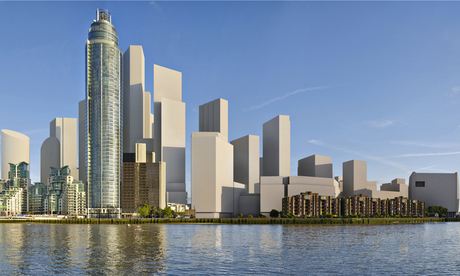πηγή http://www.theguardian.com/
An explosion of high-rise buildings will change London forever. Now 80 public figures, shocked at the scale of the plans, are demanding a say in the way the city is reshaped
Interactive: what will London's skyline look like?
Interactive: what will London's skyline look like?

How the view along the Thames from Vauxhall might look. Photograph: Hayes Davidson
When the appearance of a great city is about to be radically transformed, it is a good idea for its citizens to be shown what is going to happen and have a say in it. It is also a good idea if the city's government has a vision, or at least an overview, of what is happening.
Neither of these applies to the wave of towers about to hit London. There are plans for more than 230, at the last count. They range in height from 20 storeys to more than 60, in central and suburban locations. Yet it has taken a privately funded organisation, New London Architecture, to discover this number. When Kit Malthouse, deputy mayor for business, was presented with this figure, he was not only ignorant of it, but denied it could be possible.
On these pages we show the cumulative effect of these planned towers on key locations along the Thames, where several of the proposals are concentrated. The images are of those that are known: many more can be expected in the coming months and years. It is the first time that the future skyline has been shown to this extent, even though the technology is there to do so.
Today we also publish a statement signed by scores of leading figures in culture, politics and business, and societies representing citizens. They include architects who have won the profession's highest awards, contemporary artists, property developers, MPs, authors and the heads of colleges and museums. These are not Luddites or fogeys, they are not enemies of business or of the new, but they share simple shock at the thoughtlessness with which change on this scale is happening.
Here's another good idea: buildings in cities should not be designed in isolation, but in relation to the places in which they are set, whether these are views to and from world heritage sites, or the fabric of adjoining streets. Together with its present and future neighbours, new development should make accessible public spaces that are a pleasure to inhabit – the effects of tall buildings are as important at ground level as they are in the sky. And the larger and more prominently placed a building is, the greater the care that should be taken over its design.
Nobody could go to the places already being shaped by towers – Elephant and Castle, Vauxhall or Stratford High Street, a discus-throw from the Olympic Park – and say that these are great places to linger, or that the tall buildings now rising there enhance the experience. Images of these places in the future, when further skyscrapers will jostle for attention, suggest more of the same. New urban zones are being created with no overall idea of how the parts contribute to the whole, of the places that are being made at their base.
Rather, new London tower design tends to go out of its way to be as assertive and architecturally antisocial as possible. Strata SE1 in Elephant and Castle, with its slashed rooftop, randomised aluminium cladding patterns and bulbous form, seems to be setting out to be as hostile as possible to any future neighbour. In Stratford the fashion is for arbitrary clashing colours – another idea that kills the prospect of making coherent public places.
Nor, when you get close to a building such as St George's Tower in Vauxhall, would you say that you are in the presence of quality. Its details clash and its cladding looks cheap and plasticky. There is no great reason to believe that these surfaces will age well. Images of proposed future projects, such as the Quill in Bermondsey and 1 Merchant Square in Paddington, suggest little improvement in the future.
Combined with frantic attempts at individuality is a profound sameness. These projects tend to use the same type of cladding and floor layouts. It is sometimes said that London needs skyscrapers to make an "iconic" statement on the world stage, but these developments make it look less distinctive. And if the city tries to engage in the global race for height, it can only lose. It is outpaced by the likes of Shanghai and Dubai, the height of whose Burj Khalifa is 2.7 times that of the Shard.
If towers can sometimes look dramatic and impressive, they also bring drawbacks. They are inflexible, expensive to run and maintain and consume money, space and resources on lifts, air conditioning and structure that lower buildings do not require. Above a certain height such simple pleasures as opening windows and outdoor space become difficult. Towers disconnect residents from their surroundings.
Overcoming these issues requires effort in design, effort that is hard to see here. It was decided in the 1970s that councils should no longer build high-rise blocks for families, particularly where there were not enough open spaces and communal facilities. Those now being built are for the higher end of the market, but the lessons of the past have not been learned.
The majority of the tall buildings now proposed are residential. There is, of course, an acute shortage of homes in London, but stacks of high-rise, high-price flats are not what the city needs. In a recent Ipsos Mori poll commissioned by New London Architecture, a majority of Londoners said they would not want to live in towers. The transformation of the skyline is not driven by serving their needs, but by a bubble of overseas investment in high-end residential property. Many of these flats are likely to be left empty.
The best thing about these buildings is that, under existing planning policy, developers must make a contribution to affordable housing, which can be spent at another location. But it would be possible to build developments that are both lower and better-designed and still achieve this benefit.
We have got to this point through several factors. Early in Tony Blair's government, a taskforce led by Lord Rogers of Riverside produced a report on the "Urban Renaissance", arguing for using land more effectively and making cities more vibrant through higher densities, achieved with the help of good design and quality public spaces. As mayor of London, Ken Livingstone employed Rogers as an adviser and built these ideas into the London Plan, which guides development. The plan, and other policy statements, stress that towers are acceptable only if they "are well-designed and in the right place".
What we have now is a bastardisation of Rogers's ideas. "Density" has been translated into height, and the pieties about design and siting are almost meaningless. Significant decisions have blown holes in such policies as exist. John Prescott and Hazel Blears, when they were the ministers responsible, overturned the advice of planning inquiries into key projects. The City of London, which had a plan to confine tall buildings in a cluster around the Bank of England, permitted 20 Fenchurch Street, aka the Walkie Talkie, which stands outside it.
Boris Johnson, when first running for London mayor, vowed he would reverse Livingstone's friendliness to building high and prevent a "Dubai-on-Thames", but its creation has accelerated on his watch. The communities secretary, Eric Pickles, has told the Architects Journal: "We attach great importance to good design of buildings and neighbourhoods and have empowered communities so they can shape developments to reflect local needs."
What this means in practice is that south London boroughs such as Southwark, Lambeth and Wandsworth readily give permission for tall buildings south of the river. They do this so they can collect contributions to affordable housing and because they lack the resources to argue for long with well-financed developers. The wall of towers forming along the river is a direct expression of this.
But buildings of this prominence are a matter not just for boroughs, but for the city, the country and, given London's international importance, the world. For this reason Johnson has the power to intervene, but doesn't, much. Pickles pleads his love of communities, but, wanting to favour developers, he stands back.
So what should be done now? Peter Murray of New London Architecture has proposed a mayoral London Skyline Commission, in which experts would scrutinise the quality of new proposals and guide developers. He also wants a publicly accessible digital model of the city, which would enable everyone to see the effects of any planning application. Both would be welcome steps, but they don't go far enough. Murray's commission sounds like a (possibly improved) version of the Commission for Architecture and the Built Environment, which has existed for 15 years and is now part of the Design Council, during which London's planning has got into this state.
The city needs a clearer, more precise framework, one that states where height is acceptable and where not. It can identify opportunities for vertical growth as well as restrictions. Something like this exists already, in the rules controlling strategic views of St Paul's and the Palace of Westminster. The problem is that, where these rules do not prevail, there is often havoc.
Such a framework would be more efficient than the current system, where it has taken 10 years, three architectural practices, and untold millions of professional and legal fees, for the proposed rebuilding ofElizabeth House in Waterloo to be permitted. New York has applied strict rules to the building of skyscrapers for nearly a century, during which it became the world's most dynamic city – so rules are not bad for business.
It is not easy to work out the right policies for London. In the coming weeks the Observer, our Cities website and the Architects' Journal will develop the debate. But this effort is essential: the alternative is to accept that civic democracy is powerless to influence the effects of financial speculation.




Δεν υπάρχουν σχόλια:
Δημοσίευση σχολίου